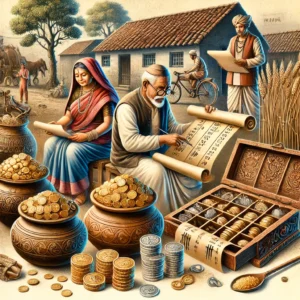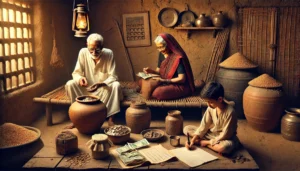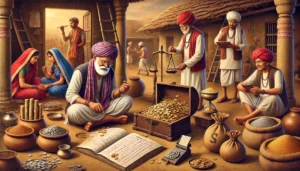
Ancient Indian money-saving techniques
Traditional Indian Money Management Techniques: How Older Generations Handled Finances Before Banks
Financial wisdom in India has been passed down through generations, shaped by cultural values, religious beliefs, and practical experiences. Before modern banking systems came into existence, Indian households and communities relied on traditional money management techniques that ensured financial stability, wealth accumulation, and social well-being. These methods, rooted in sustainability and self-reliance, continue to offer valuable insights for modern financial planning.
This article explores the diverse ways in which older generations in India managed their wealth, ensuring long-term prosperity and security.
- The Concept of “Dhana” (Wealth) in Ancient India
In ancient Indian philosophy, wealth (dhana) was regarded as a divine blessing, and its responsible management was considered a moral duty. Unlike the modern idea of wealth being primarily monetary, traditional Indian society viewed wealth holistically, encompassing land, livestock, knowledge, relationships, and gold.
Ancient scriptures like the Arthashastra by Chanakya, the Manusmriti, and the Thirukkural provided detailed guidance on ethical wealth creation, financial planning, and economic sustainability. The emphasis was on righteous earning (dharma), responsible spending, and charity (daan) to ensure social harmony.
- Gold – The Preferred Store of Wealth
For centuries, gold has been the cornerstone of Indian wealth management. Unlike paper currency, which is subject to inflation and devaluation, gold has retained its value across generations. Indian families traditionally accumulated gold in the form of jewelry, coins, and bars, considering it a portable, liquid, and secure investment.
Traditional Uses of Gold:
- Dowry and Inheritance: Gold was often passed down as part of a bride’s dowry, ensuring financial security for women.
- Collateral for Loans: In the absence of formal banks, gold was frequently pledged for loans from local lenders.
- Emergency Fund: Gold served as a financial backup during crises like droughts, wars, or family emergencies.
- Religious Donations: Temples accumulated vast gold reserves, which were used for public welfare.
Even today, Indians have one of the world’s highest private gold reserves, reflecting the deep-rooted trust in this ancient financial asset.
Table of Contents

Ancient Indian money-saving techniques
- The Barter System and Grain Banking
Before the introduction of coinage, India followed a barter economy, where goods and services were exchanged without money. This system was prevalent in villages, where farmers traded grains, livestock, spices, textiles, and metal tools.
Grain as a Financial Asset
- Many households stored surplus rice, wheat, pulses, and millets as a form of savings.
- Some community granaries functioned as informal banks, lending grains to needy families during difficult times.
- Temples also acted as food banks, distributing grains during famines.
This system ensured food security and financial stability, especially in agrarian societies.
- Community-Based Lending – Chit Funds and Rotating Savings Groups
Long before formal banking institutions, Indian communities devised self-sustaining financial networks.
Chit Funds (Bhishi, Kitty, Kuri, or ROSCA)
- Families or traders pooled their savings into a rotating fund, and each member took turns borrowing a lump sum.
- These funds operated on trust and zero formal documentation, making them accessible to those without bank accounts.
- Even today, chit funds remain popular in small towns and rural areas.
Interest-Free Borrowing (Benevolent Lending)
- Wealthy landlords (zamindars) and merchants (seths) often lent money without interest, particularly for religious or social causes.
- Borrowing from trusted family members or community elders was common and did not carry the stigma of debt as long as it was repaid honorably.
These systems encouraged financial discipline and mutual support, fostering a sense of economic cooperation.
- Land Ownership and Agricultural Wealth
In pre-industrial India, land ownership was a key indicator of wealth. Landowners enjoyed economic security, sustainable income, and generational prosperity.
How Land Contributed to Financial Stability
- Agricultural wealth: Landowners cultivated crops and earned a steady income through farming.
- Self-sufficiency: Many households relied on their land to grow food, reducing dependency on market fluctuations.
- Land as an asset: Unlike perishable goods, land value appreciated over time, making it a long-term investment.
Joint families often pooled resources to manage large agricultural estates, ensuring collective economic security.
- Savings Through Precious Items and Handicrafts
Apart from gold, traditional Indian households stored wealth in durable assets such as:
- Silver jewelry and utensils (widely used in weddings and religious rituals)
- Gemstones and pearls (preserved as a form of portable wealth)
- Silk fabrics, brassware, and ivory items (often sold during financial hardships)
These assets were not affected by market fluctuations, ensuring wealth preservation for generations.
- Temple Treasuries and Religious Wealth Management
Temples in ancient India functioned as financial institutions, collecting wealth in the form of gold, silver, and land donations. These resources were managed prudently for:
- Public welfare projects (schools, hospitals, community kitchens)
- Lending money to farmers and traders
- Building infrastructure like tanks, wells, and roads
Even today, temples like Tirupati, Padmanabhaswamy, and Shirdi Sai Baba hold vast gold reserves, continuing this tradition of financial stewardship.
- The “Char Dham” Investment Strategy
A well-known financial principle in ancient India was dividing one’s wealth into four parts:
- Daily expenses (sustenance and lifestyle needs)
- Investments (land, gold, business)
- Savings (for future emergencies)
- Charity and community support
This balanced approach ensured both personal financial security and social responsibility.

Ancient Indian money-saving techniques
- Gurukuls and Financial Education
Education played a crucial role in ancient financial wisdom. The Gurukul system taught students about:
- Sustainable wealth management
- Ethical business practices
- Investment strategies in trade and agriculture
Texts like Thirukkural, Arthashastra, and Manusmriti emphasized practical financial literacy, ensuring that wealth was handled wisely.
- Trust-Based Financial Systems and Money Lending
Before banks, merchant guilds and moneylenders (Mahajans, Seths, and Sahukars) facilitated trade by:
- Providing loans based on trust (without written contracts)
- Supporting businesses and artisans with financial assistance
- Ensuring stable local economies through ethical lending practices
While some lenders charged high interest, many followed fair lending practices, ensuring economic growth without exploitation.
Conclusion: Lessons from Traditional Financial Wisdom
India’s older generations followed a self-reliant, community-driven approach to finance. Their strategies revolved around:
- Sustainable investments (gold, land, grain)
- Debt-free living through savings and community lending
- Financial education and ethical wealth creation
- Balancing personal prosperity with social welfare
Even in today’s fast-paced financial world, these timeless principles offer valuable lessons on prudent money management, long-term security, and ethical wealth accumulation.
By reviving these ancient financial techniques, we can create a more resilient and stable economic future for generations to come.
FAQs on “Timeless Wealth Wisdom: Traditional Indian Money Management Before Banks”: Ancient Indian money-saving techniques
- How did older generations in India manage their finances without banks?
Traditional Indian societies relied on gold savings, barter systems, hundis (promissory notes), community lending, and investments in land, cattle, and grains for wealth preservation and growth.
- What were Hundis, and how did they function?
Hundis were informal credit instruments used as promissory notes or bills of exchange, facilitating trade and lending across regions. They were widely trusted and served as an early form of banking.
- How did gold play a role in financial security?
Gold was considered the safest store of value. Families accumulated gold as a hedge against inflation and economic uncertainty, passing it down through generations.
- What was the role of community-based financial systems?
Joint family systems ensured pooled income and expenses, while informal lending within communities helped members without relying on external financial institutions.
- Did older generations invest in businesses or industries?
Yes, many families followed traditional business models like trade, agriculture, and craftsmanship. They reinvested profits into expanding businesses and acquiring assets.
- How were savings and expenditures managed in joint families?
Elders or a designated family head oversaw budgeting, ensuring wealth distribution for essential needs, savings, and future investments. Frugality and financial discipline were core values.
- Were there any traditional investment methods besides gold?
Yes, investments included land acquisition, lending money with interest, grain storage for price appreciation, and cattle farming, which provided sustainable income.
- How did people handle financial emergencies without banks?
Families relied on stored wealth, community support, and mutual aid networks. Gold and silver were often liquidated in times of need.
- What lessons can we learn from these traditional financial practices?
Key lessons include the importance of saving, diversifying wealth, avoiding unnecessary debt, and fostering community-based financial support.
- Are any of these traditional practices still relevant today?
Absolutely! Concepts like gold investment, community lending, frugal living, and sustainable wealth management remain valuable even in modern financial planning.
Summary
Before the advent of modern banking, traditional Indian society had well-established financial management techniques that ensured economic stability and self-sufficiency. These methods were deeply rooted in cultural values, community trust, and long-term planning.
Wealth Preservation and Savings
Gold and silver played a crucial role as primary forms of wealth storage. Families, especially women, safeguarded their wealth in the form of jewelry, which served as both an asset and an emergency fund. Land was another key investment, passed down through generations, ensuring financial security. People also saved grains, oil, and other essentials, reducing dependency on markets and safeguarding against inflation.
Informal Banking and Lending Systems
Instead of banks, communities relied on chit funds, hundis, and moneylenders (sahukars) for loans and investments. Hundis were early financial instruments used for trade and remittances, functioning similarly to modern-day promissory notes. Merchants and traders depended on nagar seths (community bankers) for funding, with trust-based lending systems fostering economic growth.
Joint Family Economy and Financial Planning
The joint family system ensured that wealth and expenses were managed collectively. This communal approach minimized financial risks, as resources were pooled together for education, weddings, and emergencies. Every member had a role, ensuring financial sustainability across generations.
Temple and Guild-Based Financial Systems
Temples often acted as early banking institutions, where people deposited wealth for safekeeping. These funds were later used for charitable purposes, infrastructure projects, and community welfare. Merchant guilds (shrenis) functioned like cooperative banks, providing loans and supporting trade networks.
Frugality and Ethical Wealth Management
Traditional money management emphasized simplicity, savings, and ethical earning (dharma). The concept of artha (wealth) in Indian philosophy encouraged responsible financial growth while maintaining social and moral obligations. People avoided unnecessary debts and practiced mindful spending to ensure long-term financial well-being.
Lessons for Modern Times
Despite the evolution of banking systems, these age-old principles still hold value. The focus on gold investment, community-based finance, long-term planning, and debt-free living can offer timeless financial wisdom for today’s digital and fast-paced economy. Embracing these traditional techniques can help individuals and families achieve financial independence while maintaining ethical wealth management practices.
Unlock the Ancient Wisdom of Sanatan Dharma – Join Us on YouTube!
👉 Subscribe now to Prachin Sanatan Dharma and embark on a journey of enlightenment.
Explore timeless teachings, spiritual insights, and cultural richness on our YouTube channel, Prachin Sanatan Dharma. Dive deep into the essence of Sanatan Dharma through captivating videos that inspire and educate.
Related Articles
- Restful Nights: Ayurvedic Remedies and Traditional Indian Practices to Overcome Insomnia and Late-Night Habits
- The Tridevi: Lakshmi, Saraswati, and Parvati – Their Roles and Powers
- “Divine Creatures of Ancient Indian Scriptures: Exploring the Role of Animals in the Vedas, Puranas, and Mahabharata”
- Nature and Spirituality: Exploring the Sacred Essence of the Himalayas, Ganga, and Other Natural Wonders”
- “Reviving the Gurukul System: Relevance and Lessons for Modern Education”
- “Exploring Greek and Indian Mythology: Similarities Between Greek and Indian Mythology “
- “Embracing Sattvic Living: Harmonizing Mind, Body, and Soul Through Food and Lifestyle”
- “Charity and Prosperity: Exploring the Concept of Daan and Its Financial Relevance in Modern Life”
- How to Build an Eco-Friendly Home Inspired by Vastu Shastra
- Comparison of Ancient and Modern Sports: How Traditional Sports Have Influenced Contemporary Games
- “Timeless Lessons from Ancient Tales: Linking Samudra Manthan and Ganga’s Descent to Modern Ecological Challenges”
- “Reviving Sanskrit: How AI is Preserving Ancient Languages for the Future”
- “Mathura: The Sacred Land of Lord Krishna’s Divine Leelas”
- Investing for Future Generations: Lessons from Indian Traditions on Legacy Building and Wealth Preservation
- “Ancient Indian Wisdom: Timeless Lessons for Tackling Today’s Climate Crisis”
- “Artificial Intelligence and Spirituality: Transforming Ancient Practices for the Modern World”
- “Gold and Real Estate in India: Timeless Assets Shaping Financial Strategies”
- Tradition Meets Innovation: The Evolution of Technology in Hindu Rituals
- End-of-World Myths: Exploring Kali Yuga in Hinduism and Ragnarök in Norse Mythology
- Garuda, Pegasus, and Dragons: The Universal Ties of Mythical Beasts Across Cultures
- “Ancient Vimanas: Mythical Flying Machines or Evidence of Advanced Technology?”
- Time Travel in Hindu Mythology: The Fascinating Tales of Kakudmi and King Raivata
- “Divine Feminine Power in Hindu Mythology: The Legends of Durga, Saraswati, and Lakshmi”
- “Divine Beings of Sanatan Dharma: The Spiritual Significance of Sacred Animals in Hinduism”
- “Symbolism in Mythological Art: Unlocking Hidden Meanings in Ancient Temple Carvings”
- “Exploring Technological Advancements in Ancient India and Civilizations: Vimana, Metallurgy, & Water Management systems”
- Unveiling the Mysteries: Ancient Temples of Sanatan Dharma , Mysterious Temples of India
- “The Scientific Knowledge of Sanatan Dharma: Ancient Wisdom Meets Modern Science”
- Ancient Indian Sports and Games: Celebrating a Legacy of Skill, Strength & Strategy”
- “Exploring the Cosmic Link: The Connection Between Astronomy and Vedic Astrology”
- The Power of Sanskrit: Unlocking the Divine Language of the Gods
- “The End of Kaliyuga: A Sanatan Insight into the World’s Final Chapter”
- Explore more articles on Prachin Sanatan Yuga.
Ancient Indian money-saving techniques Ancient Indian money-saving techniques Ancient Indian money-saving techniques Ancient Indian money-saving techniques Ancient Indian money-saving techniques Ancient Indian money-saving techniques Ancient Indian money-saving techniques Ancient Indian money-saving techniques Ancient Indian money-saving techniques Ancient Indian money-saving techniques
Ancient Indian money-saving techniques Ancient Indian money-saving techniques Ancient Indian money-saving techniques Ancient Indian money-saving techniques Ancient Indian money-saving techniques Ancient Indian money-saving techniques Ancient Indian money-saving techniques Ancient Indian money-saving techniques Ancient Indian money-saving techniques Ancient Indian money-saving techniques
Ancient Indian money-saving techniques Ancient Indian money-saving techniques Ancient Indian money-saving techniques Ancient Indian money-saving techniques Ancient Indian money-saving techniques Ancient Indian money-saving techniques Ancient Indian money-saving techniques Ancient Indian money-saving techniques Ancient Indian money-saving techniques Ancient Indian money-saving techniques
Financial wisdom in India has been passed down through generations, shaped by cultural values, religious beliefs, and practical experiences. Before modern banking systems came into existence, Indian households and communities relied on traditional money management techniques that ensured financial stability, wealth accumulation, and social well-being. These methods, rooted in sustainability and self-reliance, continue to offer valuable insights for modern financial planning.
Financial wisdom in India has been passed down through generations, shaped by cultural values, religious beliefs, and practical experiences. Before modern banking systems came into existence, Indian households and communities relied on traditional money management techniques that ensured financial stability, wealth accumulation, and social well-being. These methods, rooted in sustainability and self-reliance, continue to offer valuable insights for modern financial planning.
Financial wisdom in India has been passed down through generations, shaped by cultural values, religious beliefs, and practical experiences. Before modern banking systems came into existence, Indian households and communities relied on traditional money management techniques that ensured financial stability, wealth accumulation, and social well-being. These methods, rooted in sustainability and self-reliance, continue to offer valuable insights for modern financial planning. Ancient Indian money-saving techniques Ancient Indian money-saving techniques
